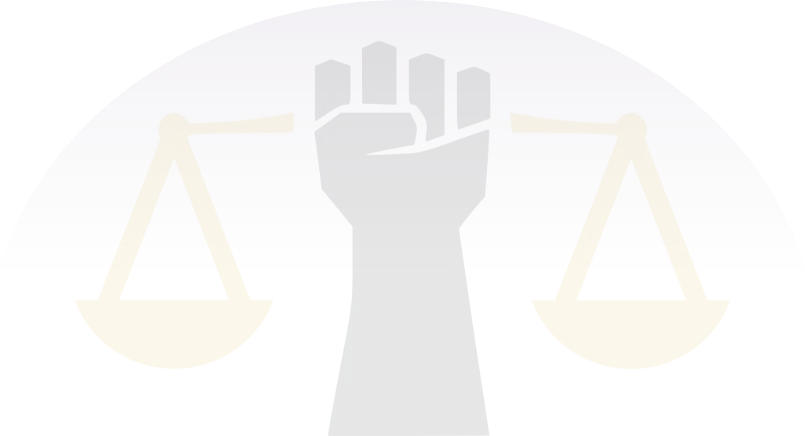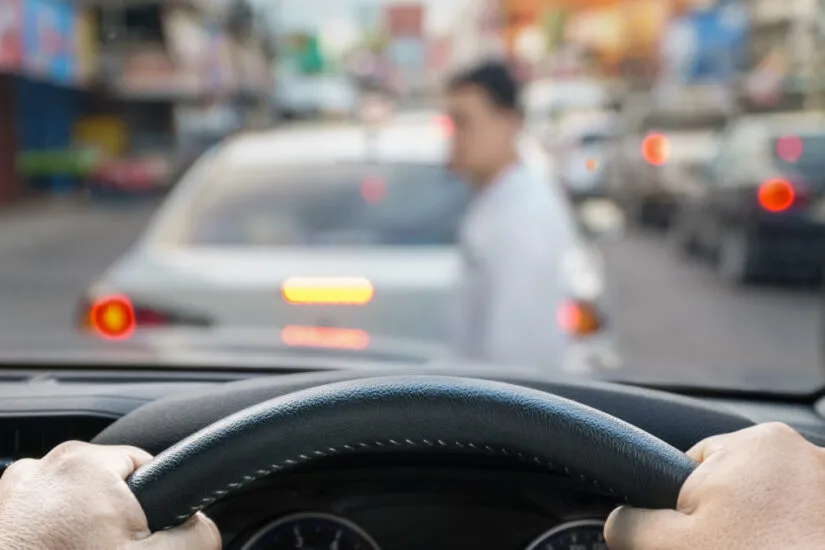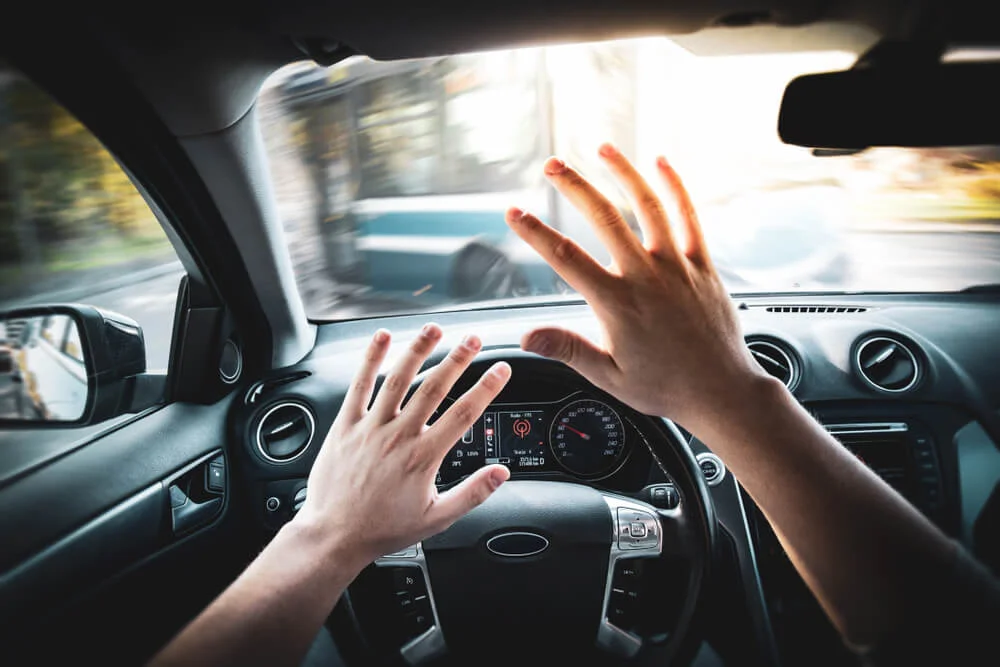

Driving is something all — if not most — of us do daily. Whether commuting to work, driving our children to school, or traveling to appointments, getting behind the wheel is required.
Sometimes, driving is done around a small town with just a few roads, familiar sites, smells, and sounds, with neighbors and businesses we know and recognize — and we enjoy these well-known surroundings.
Other times, we have to travel outside our comfort zone into large cities. We are then surrounded by unfamiliar roadways, unknown businesses and residents, strange intersections, and unexpected and sometimes unfamiliar street signs. We may feel our body’s stress mounting as we continue driving into these foreign cities.
In both situations, car accidents are a genuine possibility. When drivers are emotionally affected by their surroundings, crashes occur. If you have been the victim of a collision or a personal injury. T. Madden & Associates, P.C., can protect your legal rights and help you seek the compensation you deserve.
So why would two different driving scenarios have such varied stress responses on our bodies? For centuries, civilizations have attempted to create order and bring predictability to their environments. From streets showcasing a connection to nature to tiny details that allow movement to flow through the alleyways.
While many urban cities have begun to transform the landscapes surrounding highways and roadways, many cities still have a cold, stress-inducing feel. These industrial areas are filled with buildings and factories. Your body goes into a state of discomfort, feeling the added stress and annoyance of being behind the wheel.
The growth of an urban area often leads to air and noise pollution from the heavy traffic and surrounding businesses. Studies have shown that the noise from traffic alone can create a physiological stress response that ultimately will impact a driver’s well-being. If a driver has long-term exposure to these driving situations, the emotional and physical toll can be severe.
The physical responses that a driver can feel during these times of stress include an elevated heart rate and recurring sleep disturbances. Gridlock and overcrowded streets can cause a driver to experience aggression and frustration with the situation, leading to road rage or impulsive driving decisions.
Very nice people who are there only to help you. He get u back your max amount for your settlement. The process is very fast. I give 5 stars.
Thank you!! Attorney T Madden and staff were wonderful!!
Great service. Took the time to explain every process to me. Felt very comfortable to contact them for any questions I had. I would recommend!
Very professional. Tiffany did a great job updating me on my son’s case. Would definitely recommend to anyone. They took great care of us.
They have been fantastic. No matter how busy they are they have time for you. Renee is very friendly and caring. Keeps you up to date with your case, good or bad. I never have to call them and if I do call the phone is always answered. If not they call you back ASAP. I recommend them to everyone.
I was represented by T. Madden and Nicholas Schnyder on my car accident case. They and their staff were very professional, willing to answer any and all of my concerns. If they were not available, I would receive a call back within a timely manner. I am very satisfied with how my case came out and I would highly recommend their services.
The warmth, dedication and empathy shown in my daughters case, put me at ease knowing I had placed her in good hands. Due to the professionalism and thoroughness shown by the staff, I would definitely recommend Attorney Madden to family and friends. My daughter was extremely pleased with her settlement.
This firm did an amazing job. In meeting the gang over the period of the case, I can honestly say that each and ever person I was in contact with was professional and extremely helpful. I am humble and graciously blessed for their work. Thank Terrance Madden and Associates.
Shanera and team work effortlessly to get a good settlement. They definitely understood the assignment when it came to our case. I would definitely use them again.
I will sincerely like to thank T Madden & Associates for the professional and awesome job that they done handling my case. They went to work right away, and answered any questions and concerns that I had. I was recommended by a friend and I highly recommend this office for you as well. One call and that’s all. Don’t hesitate!!
Excellent Experience!! I appreciate how they took charge of the insurance company and made them give me what I deserved. I highly recommend T. Madden & Associates, P.C.
Thank you so much to T. Madden and Associates. Your promptness, diligence and professionalism in handling my case was awesome. The end results was more than I could imagine. Thank you Attorney Madden, Rick Polk and Maya. God Bless!
I will like to publicly thank Mr. Watson, Mr. Madden, and Mr. Rick the dedication to he me handle my case and respect to me was outstanding. I mentioned that I wanted to publicly thank them because I want potential clients to know that this is a real review on behalf of a great team.
Professional and knowledgeable. Provides you with honest answers and the best possible advice towards your case.
T. Madden & Associates P.C. is the best in the business. They settled my case and I’ve received a large settlement.
It was good service , the office was friendly and my case was quick and efficient.
Mr. Madden is A1!! The staff is professional always knowledgeable of your case.
Suffered injuries with a semi-truck, called this law firm. They took care of my case. Great people.
Great personal injury attorneys! Excellent service! Thank you for helping resolve my situation successfully (and promptly).
So glad to have found T Maddison and associates. I had a car accident and they assisted me in getting a great compensation. Thank you to the whole team.
Staff are incredibly attentive and welcoming from front to end. This group is very professional with the sensitive nature of my needs.
Tasha and Rick where amazing made sure to keep me updated when they had information. Also, they were great enough to stay open later for me. Thank you!
T Madden and Associates are awesome. They got me what I felt was a great settlement. I highly recommend them to anyone injured in a car accident that isn’t their fault!
Madden & Associates was recommended to me by a friend and they really hit it out of the park dealing with my vehicle crash lawsuit. Communication was always transparent, honest and responsive. I was always treated with respect and dignity and my worries we’re always addressed without being condescending (which I have dealt with in the past with other lawyers). Thank you Madden for showing up for me when I needed it the most. Highly recommend!
I thank you Terance Madden for not only being professional, courteous and knowledgeable, but also your experience. I really appreciate your passion for work and your compassion for your clients. You worked so hard for me. The dedication of your staff to getting a positive outcome for me, was extremely unique. You will never find a better attorney than Terance Madden and Associates. I hope I never need an attorney again, but if I do I will only contact T. Madden & Associates.
I had a case that was taking care of By T. Madden & Associates. Very professional and efficient. I didn’t have to lift a finger. All info was provided to me in a timely manner. I appreciate the courteous service. I recommend them any day.
I used TMAPC services for my car accident and the service was phenomenal! I’d definitely use them in the future.
These guys are life changing, thanks for helping me out with the truck crash, I really needed the money and you all got it for me”
T Madden & Associates was the best they gave me and my son the best service a person could ask for. They was very friendly sn I didn’t have to call them about anything they called me. If I was the have another accident hoping that I don’t I will definitely let them handle my case again
Attorney Madden handled my motorcycle accident and got me an amazing settlement fairly quickly and it was life changing. Thanks again.
Personal injuries due to another person’s actions suck!! I called this firm because I was referred. I am grateful. My initial call was answered by Natasha. She was kind and professional. Once my case was settled, I was contacted by Dee to come by and pickup my check. I would recommend calling this firm if you need personal injury help.
T.Madden & Assoc. Is a professional, outstanding, and honest law firm which is something that is rare. Their customer service skills and knowledge is impeccable!
T. Madden & Associatees is the best decision I could have made. They resolved my collision (auto accident) efficiently and with great results. They provide great service and I like how they give back.
Simply Amazing! I am very pleased with the way T. Madden & Associates handled my daughter’s auto injury case. T. Madden came highly recommend from a friend at church and he did not disappoint. They went to work on her case like she was family. The entire staff was always helpful.
My nephew was involved in a car accident, this firm handles his case with professionalism and gave my sister the confidence she needed to trust things would be fine. Thank you for your hard work, reassurance and time.
T Madden & Associates were great! No one wants to need a lawyer, but if you do, you want someone to make everything easy. And, they made it easy, I made one phone call and they took care of the rest. They gave updates on the progress which was reassuring. I highly recommend them to everyone.
A recent study by the World Health Organization (WHO) concluded that the noise from road traffic increased the risk of ischemic heart disease and other cardiometabolic diseases such as diabetes, obesity, and stroke. Nighttime driving noise can also lead to further health issues such as cardiovascular disease caused by the increased vascular oxidative stress and stress hormones.
Urban traffic scenarios often lead to swerving in and out of traffic and quickly speeding up and slowing down, resulting in accidents that could have been easily avoided had it not been for the urban roadway stressors.
Perceived control is another psychological principle that drivers of urban areas do not experience. This is the feeling that one is able to exert control over certain events or situations. Clear signage, well-designed intersections, and updates using real-time technology are all aspects that help a driver feel in control. Most urban areas lack these simple devices and layouts.
When drivers are in an unwelcoming environment, their social behavior is affected. They no longer feel a sense of community or oneness. Instead, they are overwhelmed with a feeling of fight or flight. They become defensive and not courteous to their fellow drivers. Rural areas that provide a small-town feel cause drivers to have appropriate social behaviors and values that lead to courtesy on the roads, leading to a more supportive and positive driving experience for all drivers.
Two clients who were special needs students were being hit and abused by the paraprofessionals in a public school system. T. Madden & Associates took on the case and secured 1.25 MILLION Dollars against 1 of 4 defendants involved in the wrongful actions. The case remains open as T. Madden & Associates continues fighting for the policy limits of the remaining defendants; over $10 MILLION.
A father and son had a terrible valentine day when they found themselves the victim of a trucking collision. T. Madden & Associates initiated the case which led to the clients receiving over 3.25 MILLION Dollars.
A group of employees were experiencing a hostile work environment (HWE) and sexual harassment, prior to T. Madden & Associates was able to have the perpetrator fired and the ladies 1.25 MILLION Dollars.
Client was involved in a collision with a Yukon while driving his Honda motorcycle. The injured party was taken to the emergency room. The call was made to the firm from a hospital in Columbus, GA. We were able to serve the client as if he was next door. T. Madden & Associates was able to recover the policy limits of $1.25 MILLION for the client.
T. Madden & Associates, P.C. was able to bring justice and $1,050,000 for a couple when nobody could tell them how their son wound up at the bottom of a swimming pool. Many think if nobody saw how the drowning happened, then there can’t be a monetary recovery. T. Madden & Associates would not accept that as a proper response. A wrong occurred and this law firm made the defendant’s pay.
Three persons were involved in a collision with a Marta bus in a case of distracted driving. The public trial resulted in a $960K recovery for the 3 victims.
On the other hand, rural areas can create a physical environment that can change human behavior, including the availability of multiple parking spaces, the presence of traffic signs, and the aesthetics and layout of the roadways.
Measures that produce a more calming environment, such as speed bumps, narrow roads, and roundabouts, can encourage drivers to exercise safer and slower driving behavior. The presence of these features can signal drivers to proceed with caution through their instinctual understanding of environmental cues.
In a similar scenario, people consider choosing modes of transportation that are more sustainable when they are surrounded by the accessibility of public transit, bike-only lanes, and pedestrian-friendly zones.
When appropriate social interactions are encouraged through a mixed-use neighborhood containing a blend of recreational spaces and commercial and residential buildings, a form of community bonding occurs. This type of environment creates functionality and social ability. People have an innate sense of community responsibility that influences our driving behavior, causing consideration and respectfulness that reduces the chances of road rage or driver aggression.
Quieter and greener environments can affect driver psychology. When drivers experience a peaceful drive that has excess noise blocked out and green spaces to break up the visual clutter of urban congestion, they experience an improved mood and lowered stress. This allows for calmer and more mindful habits while driving.
The design of urban areas within cities can often directly reflect the social inequities that occur statewide. The availability of public transportation, the condition of the roads, and available parking spaces could vary from one neighborhood to another.
Unfortunately, the funding provided to the state is not evenly dispersed from one community to the next. The disparities in urban communities can directly influence the experiences that drivers have while using roadways and can bring to light the much larger social injustice issues occurring in urban roadway design.

If you have been the victim of an accident in an urban Georgia area, let the Georgia car accident attorneys at T. Madden & Associates P.C., represent you. Call our black-owned business today for a free case evaluation so we can protect your legal rights.